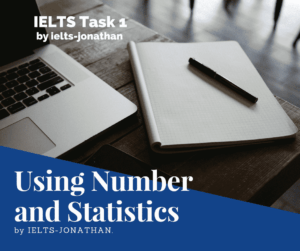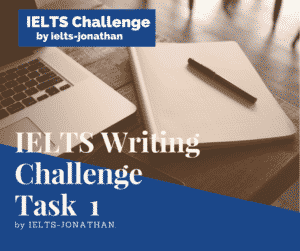IELTS Writing and Vocabulary – Numbers and Statistics
It is important that you can use and describe numbers, percentages, or fractions correctly to gain marks in IELTS Task 1.
You should remember you need only describe the significant features.
I often see common mistakes such as using numbers incorrectly and also describing minor details which lowers your IELTS Band Score.
So I have made this article for you and given some examples to show different ways of using numbers
Top Tips for numbers.
I recommend that you note in your vocabulary journal the most common ways of using numbers in English.
I also suggest when you look at an IELTS Task 1, you use this article to help you apply different structures to describe the pictorial information presented in TASK 1.
Here is a basic table to help you understand the following article.
Year 2000 2010
Cost £4000 £6000
WENT UP / WENT DOWN
You can use the following phrases to describe different units
The price of something went up by £2000, from £4000 to £6000. (numbers)
The price of something went up by half, from £4000 to £6000. (fractions)
The price of something went up 50%, from £4000 to £6000. (percentages)
DOUBLE / TREBLE
Further phrases you can use to show increase are ‘double’, ‘treble’ but note how the phrases are used, that they are verbs and that they don’t show a decline.
The price of something doubled, from £4000 to £8000.
The price of something trebled, from £4000 to £12000.
The number of unemployed people trebled between 1996 and 2006.
FOLD / TIMES
The price of something went up twofold.
The price of something went up threefold
The price of something went up fourfold.
Here the twofold phrase is an adjective + noun (twofold + Increase)
There was a twofold increase in the number of unemployed people between 1996 and 2006.
And here the twofold phrase is a verb + adverb (increased + twofold)
The number of unemployed people increased twofold between 1996 and 2006.
If you have read my other articles then you will notice the examples below are good example of paraphrasing
There was a twofold increase in the number of unemployed people between 1996 and 2006.
The number of unemployed people increased twofold between 1996 and 2006.
Comparing Two figures in an Image
You can use these phrases to compare 2 , 3 or 4 times as much.
Notice how they are interchangeable.
TWICE AS +AS / TWICE AS + COMPARED TO
There were twice as many unemployed people in 1996 as in 2006.
Twice as many people were employed in 1996 compared to 2006
Twice as many people were unemployed in 1996 compared to 2006.
There were twice as many unemployed in 1996 as in 2006.
THREE TIMES AS, AS / COMPARED TO
Here are a few more examples for you to study
1992 1994 1996 1998
1500 3000 9000 36000
The figure doubled between 1992 and 1994
The figure trebled between 1994 and 1996.
The figure quadrupled from 1996 to 1998.
There was a twofold increase between 1992 and 1994.
More Examples:
The number went up sixfold between 1992 and 1996.
The number in 1996 was six times more than the 1992 figure.
The figure in 1998 was four times the 1996 figure.
Here are some examples of how you can use fractions in IELTS Writing Task 1.
I recommend that if you are using fractions then you should focus on the most significant features only.
I often see students who waste time on writing about minor details using fractions and be penalised in the IELTS exam.
Here is the table we will use
1982 1984 1986 1988
1000 800 400 100
And here are some examples using the table.
You should note the singular and plural forms of fractions
Between 1982 and 1984, the figure fell by one-fifth.
Between 1984 and 1986, the figure went down by a half.
The figure in 1988 was one-tenth of the 1982 total.
Pay attention to whether the fraction is Singular or Plural.
Singular Plural
A half two halves
One-third two-thirds
A quarter two quarters
One-fifth two-fifths
One-sixth two-sixths
Adjectives that modify numbers
If you want to show the examiner your writing ability and increase your vocabulary Band score you can use adjectives to modify numbers and
It will increase your band score for vocabulary marking:
Adjective: Hefty/staggering/massive
Use: use for large numbers
Example: a hefty 90 per cent of … a massive 85 per cent increase ….
Adjective: Modest
Use: use for percentages
Example: a modest 20 per cent of …between 15 and 40%
Adjective: Mere/tiny
Use: use for small numbers
Example: a mere 10 per cent of …a tiny 10 per cent of …
Adjective: Overwhelming + majority
Use: use with the word majority
Example: an overwhelming majority of …
Adjective: Small/ tiny + minority
Use: use with the word minority
a small minority of
In Conclusion
It is important that you can use and describe numbers, percentages, or fractions correctly to gain marks in IELTS Task 1.
Remember you need only describe the significant features and don’t explain the reasons why.
Describing minor details is a waste of your time and lowers the score.
I hope you found both this article and the links useful.
You can find more IELTS information on my Facebook page or this website.
I also run IELTS Challenges.
Sign UP and Join In.
Best
Jonathan
IELTS-Jonathan
I’m Jonathan
I’ve taught IELTS and University English in more than a dozen universities and schools around the world.
I’m a parent, traveller and passionate about language teaching and helping students achieve their dreams.
Whilst living in Austria or working in Asia, I run IELTS courses to help students get to where they want to be.
If you are serious about IELTS, connect with me to see how I can help you.

The Best Approach to Task 2 Writing
Paragraphing in Task 2 Writing
Writing – Benefits of a Foreign University Education






Was this helpful? Leave a comment :)